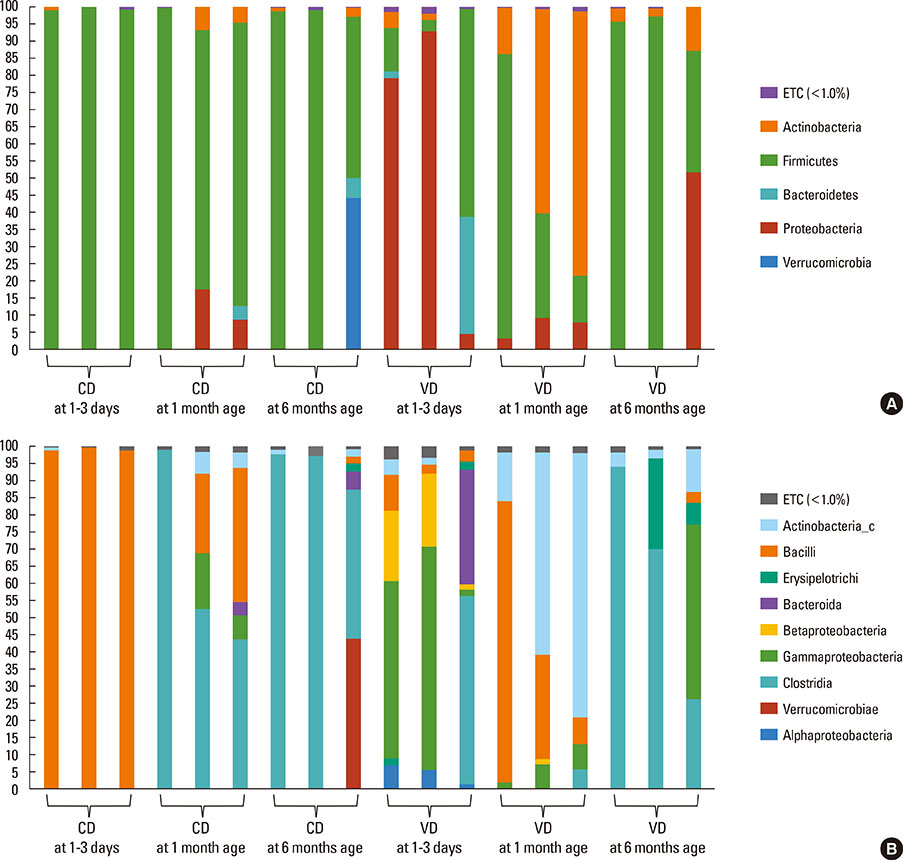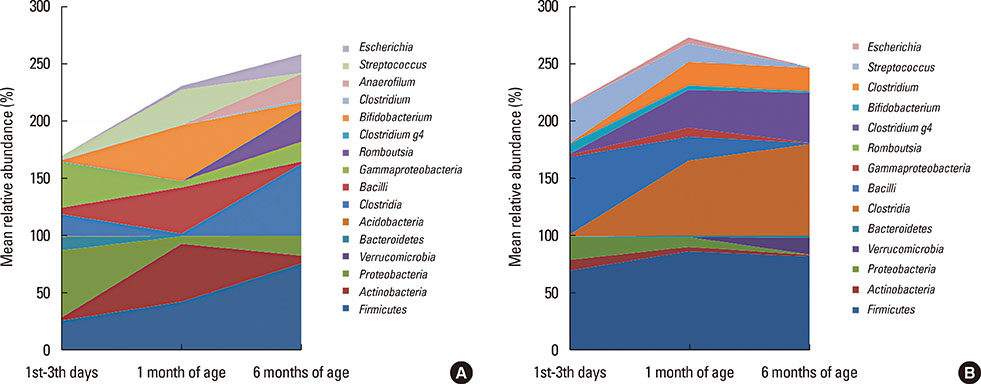Allergy Asthma Immunol Res.
2016 Sep;8(5):471-477. 10.4168/aair.2016.8.5.471.
Dynamics of Gut Microbiota According to the Delivery Mode in Healthy Korean Infants
- Affiliations
-
- 1Department of Pediatrics, Inje University Haeundae Paik Hospital, Busan, Korea.
- 2Department of Environmental Health, University of Cincinnati College of Medicine, Cincinnati, Ohio, USA.
- 3Asan Institute for Life Sciences, University of Ulsan College of Medicine, Seoul, Korea.
- 4Department of Environmental Health Research, Seoul Medical Center, Seoul, Korea.
- 5Department of Pediatrics, Childhood Asthma and Atopy Center, Environmental Health Center, Asan Medical Center, University of Ulsan College of Medicine, Seoul, Korea. sjhong@amc.seoul.kr
- 6Department of Pediatrics, Hallym University Sacred Heart Hospital, Hallym University College of Medicine, Anyang, Korea.
- 7Department of Pediatrics, CHA University School of Medicine, Seongnam, Korea.
- 8Department of Pediatrics, Pusan National University Yangsan Hospital, Pusan National University College of Medicine, Yangsan, Korea.
- 9Department of Pediatrics, Korea Cancer Center Hospital, Seoul, Korea.
- 10Department of Pediatrics, Seoul National University Bundang Hospital, Seongnam, Korea.
- 11Department of Pediatrics, Inje University Sanggye Paik Hospital, Seoul, Korea.
- KMID: 2295158
- DOI: http://doi.org/10.4168/aair.2016.8.5.471
Abstract
- Microbial colonization of the infant gut is unstable and shows a wide range of diversity between individuals. Gut microbiota play an important role in the development of the immune system, and an imbalance in these organisms can affect health, including an increased risk of allergic diseases. Microbial colonization of young infants is affected by the delivery mode at birth and the consequent alterations of gut microbiota in early life affect the development of allergic diseases. We investigated the effects of the delivery mode on the temporal dynamics of gut microbiota in healthy Korean infants. Fecal samples were collected at 1-3 days, 1 month, and 6 months after birth in six healthy infants. Microbiota were characterized by 16S rRNA shotgun sequencing. At the first and third days of life, infants born by vaginal delivery showed a higher richness and diversity of gut microbiota compared with those born by cesarean section. However, these differences disappeared with age. The Bacteroides genus and Bacteroidetes phylum were abundant in infants born by vaginal delivery, whereas Bacilli and Clostridium g4 were increased in infants born by cesarean section. The Firmicutes phylum and Bacteroides genus showed convergent dynamics with age. This study demonstrated the effect of delivery mode on the dynamics of gut microbiota profiles in healthy Korean infants.
Keyword
MeSH Terms
Figure
Cited by 2 articles
-
Probiotics as a Potential Immunomodulating Pharmabiotics in Allergic Diseases: Current Status and Future Prospects
Garima Sharma, Sin-Hyeog Im
Allergy Asthma Immunol Res. 2018;10(6):575-590. doi: 10.4168/aair.2018.10.6.575.Modifiable prenatal environmental factors for the prevention of childhood asthma
Hyo-Bin Kim
Allergy Asthma Respir Dis. 2019;7(4):179-185. doi: 10.4168/aard.2019.7.4.179.
Reference
-
1. Kim WK, Kwon JW, Seo JH, Kim HY, Yu J, Kim BJ, et al. Interaction between IL13 genotype and environmental factors in the risk for allergic rhinitis in Korean children. J Allergy Clin Immunol. 2012; 130:421–426.e5.2. West CE, Renz H, Jenmalm MC, Kozyrskyj AL, Allen KJ, Vuillermin P, et al. The gut microbiota and inflammatory noncommunicable diseases: associations and potentials for gut microbiota therapies. J Allergy Clin Immunol. 2015; 135:3–13. quiz 4.3. Kim BJ, Lee SY, Kim HB, Lee E, Hong SJ. Environmental changes, microbiota, and allergic diseases. Allergy Asthma Immunol Res. 2014; 6:389–400.4. Lee SY, Kang MJ, Kwon JW, Park KS, Hong SJ. Breastfeeding Might Have Protective Effects on Atopy in Children With the CD14C-159T CT/CC Genotype. Allergy Asthma Immunol Res. 2013; 5:239–241.5. Renz H, von Mutius E, Brandtzaeg P, Cookson WO, Autenrieth IB, Haller D. Gene-environment interactions in chronic inflammatory disease. Nat Immunol. 2011; 12:273–277.6. Bisgaard H, Bønnelykke K, Stokholm J. Immune-mediated diseases and microbial exposure in early life. Clin Exp Allergy. 2014; 44:475–481.7. Biagi E, Nylund L, Candela M, Ostan R, Bucci L, Pini E, et al. Through ageing, and beyond: gut microbiota and inflammatory status in seniors and centenarians. PLoS One. 2010; 5:e10667.8. Yatsunenko T, Rey FE, Manary MJ, Trehan I, Dominguez-Bello MG, Contreras M, et al. Human gut microbiome viewed across age and geography. Nature. 2012; 486:222–227.9. Lozupone CA, Stombaugh JI, Gordon JI, Jansson JK, Knight R. Diversity, stability and resilience of the human gut microbiota. Nature. 2012; 489:220–230.10. Biasucci G, Rubini M, Riboni S, Morelli L, Bessi E, Retetangos C. Mode of delivery affects the bacterial community in the newborn gut. Early Hum Dev. 2010; 86:Suppl 1. 13–15.11. Russell SL, Gold MJ, Reynolds LA, Willing BP, Dimitriu P, Thorson L, et al. Perinatal antibiotic-induced shifts in gut microbiota have differential effects on inflammatory lung diseases. J Allergy Clin Immunol. 2015; 135:100–109.12. Penders J, Thijs C, Vink C, Stelma FF, Snijders B, Kummeling I, et al. Factors influencing the composition of the intestinal microbiota in early infancy. Pediatrics. 2006; 118:511–521.13. Bager P, Wohlfahrt J, Westergaard T. Caesarean delivery and risk of atopy and allergic disease: meta-analyses. Clin Exp Allergy. 2008; 38:634–642.14. Pistiner M, Gold DR, Abdulkerim H, Hoffman E, Celedón JC. Birth by cesarean section, allergic rhinitis, and allergic sensitization among children with a parental history of atopy. J Allergy Clin Immunol. 2008; 122:274–279.15. Seo JH, Kim HY, Jung YH, Lee E, Yang SI, Yu HS, et al. Interactions between innate immunity genes and early-life risk factors in allergic rhinitis. Allergy Asthma Immunol Res. 2015; 7:241–248.16. Lee SY, Yu J, Ahn KM, Kim KW, Shin YH, Lee KS, et al. Additive effect between IL-13 polymorphism and cesarean section delivery/prenatal antibiotics use on atopic dermatitis: a birth cohort study (COCOA). PLoS One. 2014; 9:e96603.17. Jakobsson HE, Abrahamsson TR, Jenmalm MC, Harris K, Quince C, Jernberg C, et al. Decreased gut microbiota diversity, delayed Bacteroidetes colonisation and reduced Th1 responses in infants delivered by caesarean section. Gut. 2014; 63:559–566.18. Park SH, Kim KA, Ahn YT, Jeong JJ, Huh CS, Kim DH. Comparative analysis of gut microbiota in elderly people of urbanized towns and longevity villages. BMC Microbiol. 2015; 15:49.19. Dominguez-Bello MG, Costello EK, Contreras M, Magris M, Hidalgo G, Fierer N, et al. Delivery mode shapes the acquisition and structure of the initial microbiota across multiple body habitats in newborns. Proc Natl Acad Sci U S A. 2010; 107:11971–11975.20. Eckburg PB, Bik EM, Bernstein CN, Purdom E, Dethlefsen L, Sargent M, et al. Diversity of the human intestinal microbial flora. Science. 2005; 308:1635–1638.21. Troy EB, Kasper DL. Beneficial effects of Bacteroides fragilis polysaccharides on the immune system. Front Biosci (Landmark Ed). 2010; 15:25–34.22. Penders J, Gerhold K, Thijs C, Zimmermann K, Wahn U, Lau S, et al. New insights into the hygiene hypothesis in allergic diseases: mediation of sibling and birth mode effects by the gut microbiota. Gut Microbes. 2014; 5:239–244.23. van Nimwegen FA, Penders J, Stobberingh EE, Postma DS, Koppelman GH, Kerkhof M, et al. Mode and place of delivery, gastrointestinal microbiota, and their influence on asthma and atopy. J Allergy Clin Immunol. 2011; 128:948–955.e3.24. Andersson AF, Lindberg M, Jakobsson H, Bäckhed F, Nyrén P, Engstrand L. Comparative analysis of human gut microbiota by barcoded pyrosequencing. PLoS One. 2008; 3:e2836.





